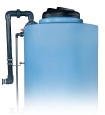Cross-linked polyethylene tanks withstand greater pressure, in part because of the rotational molding manufacturing process. Rotational molding is by far the best process to create a cross-linked polyethylene chemical storage tank.
Topics:
Value Added,
Tank Design and Materials
With some chemicals, it’s critical to keep them cool because they will lose their concentration when they heat up. Sodium Hypochlorite is a prime example of that. As it heats up, it starts to lose its strength, and it begins to release gas and free radicals. Its strength can diminish dramatically with heat and UV. So it’s important to keep the chemical as cool as possible from the moment it arrives at your facility. Other chemicals are similar—if they become too warm, they won’t perform as well as you need them to.
Topics:
Installation and Field Service,
Tank Design and Materials
Clean-in-place (CIP) systems are becoming more and more popular in the food manufacturing industry. The system design makes cleaning the interior surfaces of a storage tank and the lines going out of it more effective and efficient without having to enter the tank. They also allow for a thorough cleaning with less exposure to harmful chemicals or contamination of food and beverage mixtures. Many hazardous situations are safer because of CIP systems, but they require certain considerations to be effective. Let’s look at how to make your clean-in-place system most effective.
Topics:
Chemicals
Surfactants are the corn syrup of the chemical world—they’re in all kinds of products you’d never expect. Most people know that surfactants are an active ingredient in detergents, but you can also find them in a wide range of cleaning products, wetting agents, emulsifiers (including motor oil), foaming agents or dispersants.
Topics:
Tank Design and Materials,
Chemical Storage
Some companies need to place their chemical storage tanks underground because of space limitations, or for aesthetic reasons. Steel tanks and reinforced tanks are built to withstand the external pressure that is applied underground, but what about lightweight plastic tanks? While plastic storage tanks have many advantages over other tank materials, polyethylene is not the solution for underground storage. Here’s why.
Topics:
Installation and Field Service,
Value Added
Various types of chemical storage systems have handrails along the top of the tank, but Poly Processing tanks don’t. Polyethylene tanks can’t support handrails, and the tanks shouldn’t be walked on. The domed surface can be very slippery, and the plastic can become brittle over time and possibly crack under a person’s weight. So how do you safely inspect manways, check gauges, and service level sensors or mixers?
Topics:
Fittings and Accessories
When building your storage tank system, it’s important to not only carefully consider the tank itself, but also the fittings and accessories. An important part of your tank is your manway cover. Failing to understand the purpose and function of the manway can threaten the safety of your employees and result in leaks, tank damage, and environmental hazards. Let’s look at three things you should consider when choosing a manway cover. We’ll also introduce the best options for each consideration.
Topics:
Venting
There are several types of chlorine sources that water treatment plants can use: chlorine gas, liquid sodium hypochlorite, or onsite production. Chlorine gas can be more cost effective, but a growing number of states are converting to bulk sodium hypochlorite or bleach. If chlorine gas is more economical, why would water treatment plants convert to sodium hypochlorite?
Topics:
Applications,
Chemical Storage
A leaky fitting is a serious issue that could put your employees in danger and cause damage to surrounding equipment. Leaked chemicals are a financial loss, and they can create serious environmental issues that plague your company for decades. Our field service team will occasionally receive calls from concerned customers who need help fixing a leaking fitting on their chemical storage tank. It's not an issue that comes up often so many people are not sure what caused the issue or what to do next.
Topics:
Fittings and Accessories
If you’ve seen hairline cracks like spiderwebs on your chemical storage tank, you might wonder if you’re looking at a future problem. That’s a good question. The short answer is, maybe. The long answer is a little more helpful, and this article will outline next steps for dealing with hairline crackling, called crazing.
Topics:
Chemical Storage



